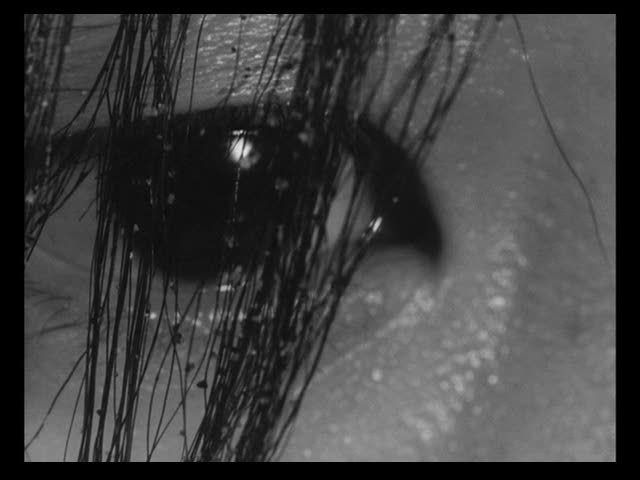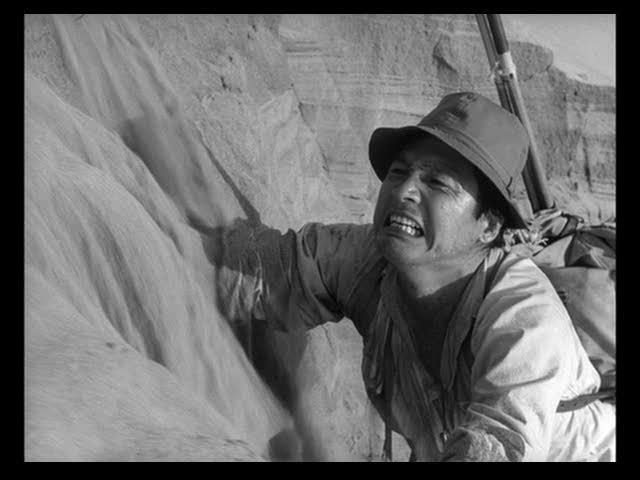
Hiroshi Teshigahara's collaboration with the novelist Kôbô Abe yielded a stunning, beautiful body of work centering around themes of alienation, modernity and identity. The most famous of these films is Woman in the Dunes, faithfully adapted from Abe's novel of the same name. As with all of Abe's work, both the novel and the film are infused with a spirit of deadpan surrealism, the character of which can especially be seen in Abe's male protagonists, who tend to accept whatever outrageous, outlandish occurrences happen to them with a degree of stoicism and a disarming lack of surprise. They may struggle against the cruel vagaries of fate that create their predicaments, but they never seem startled by the cruelty, never react with the visceral emotion one might expect. In one of Abe's later novels, a man begins sprouting vegetables from his skin and reacts only with a vague curiosity, happy to have such a convenient source of nourishment. The unnamed protagonist of Woman in the Dunes is not quite as unflappable, but he does seem strangely detached from the strangeness of the problem he faces.
He's an entomologist on a three-day vacation at the beach, hunting for rare insects in the sand — he wants to make a name for himself by discovering a new variant species of sand beetle. While at the beach, he discovers he's missed the last bus and is forced to stay the night at the home of one of the villagers. This village is rather unusual, however, buried beneath the sand, with solitary homes located at the bottom of deep sand pits, reachable only by rope ladders. The man spends the night there, in the deeply buried home of a local woman (Kyôko Kishida), but when morning comes he finds that he has been trapped: the rope ladder is gone, the sides of the pit are too steep and the sand too loose for escape. He is expected to be this woman's "husband," because now that her own husband and daughter have died, she needs a man in the house to help her with the village's nightly task of shoveling away the sand that slides down into the pit every day. The man rebels against his imprisonment, resisting in various ways, but the casual absurdity of Abe's writing carries through in the way this surreal situation is presented without fuss or drama.
In this respect, Teshigahara's lush, sensuous images are a perfect complement to Abe's sensibility. The understated surrealism of this story is enhanced by the director's tactile images, which give a sumptuous hyper-reality to everything that's happening. The texture of sand naturally defines the film, sand like a liquid, sand running in rivers and currents, pouring down slopes, oceans of sand stretching as far as the eye can see, striated with regular patterns. The sand is everywhere, forming the very fabric of the landscape, the fluid, shifting foundations of everything within sight, and yet it is also granular, composed of millions of tiny particles, clinging to the smooth surfaces of skin, dot-like grains of sand caked or dusted across every inch of open space. Teshigahara frequently inserts abstracted closeups, panning across the skin of his two protagonists, exploring the textures of skin roughened by the sand clinging to it, the grit filling the pores, running through the lines and indentations in naked flesh.

There's a sensuous, sexual quality to the film, which confines this man and woman in close quarters together, surrounded on all sides by the womb-like walls of the pit they live in. They are thrown together as though married, and their peculiar circumstances unite them in the shared work of keeping the sand from closing in — it is an enforced but powerful intimacy. The man initially resists this imprisonment, questioning this ridiculous way of living, which he likens to trying to build a house on water. His acceptance of his new situation is in some ways predicated on his acceptance of Abe's own central theme: that all ways of living are inherently absurd, that the conditions of life itself are ridiculous and surreal, that human civilization is in large measure a struggle to impose meaning and order upon chaos and insanity. Before his captivity, the man is already alienated from this society, feeling overwhelmed by the pressures of life, the obsessive cataloging of people. One of his internal monologues lists the prodigious number of ID cards and documents that society has produced to give people identities and specific places in the social order, to define what they can and cannot do, who they are and what their function is.
This man is a part of this system but feels lost in it, and his chosen profession is a pitiful attempt to find an identity for himself: he believes that by discovering a new species of insect, his name will be immortalized in science text books, in however small a way, and that his identity will be secure. The trap he finds himself in is thus a brilliant metaphor for life as Abe sees it: we're all just shoveling sand, biding time, throwing ourselves into pursuits that seem to us to have varying levels of usefulness or nobility, but which in fact are simply distractions, ways to pass the time of life. Woman in the Dunes is a deeply existentialist film, a film that deals with the question of what life means at its root level. Are we all just filling up the time while we're here? What does it mean to live? To do anything? If we're teachers or scientists, people whose lives have purpose and rationality, is what we're doing really of more value, ultimately, than shoveling sand?
Nice review. I also reviewed this film a while back. It truly is great.
ReplyDeleteThere are two other Teshigahara films that warrant serious attention, PITFALL and THE FACE OF ANOTHER, but WOMEN IN THE DUNES is definitely his masterpiece. What has always amazed me with this film is its obsessive attention to detail, and the sensory transcription of sand, which in this case doesd make you feel, taste, smell the small particles, and transport you to this special claustrophobic other-wordly place.
ReplyDeleteYou have typically penned a master-class analysis of this Japanese masterwork, and your ending is magisterial:
"The trap he finds himself in is thus a brilliant metaphor for life as Abe sees it: we're all just shoveling sand, biding time, throwing ourselves into pursuits that seem to us to have varying levels of usefulness or nobility, but which in fact are simply distractions, ways to pass the time of life. Woman in the Dunes is a deeply existentialist film, a film that deals with the question of what life means at its root level. Are we all just filling up the time while we're here? What does it mean to live? To do anything? If we're teachers or scientists, people whose lives have purpose and rationality, is what we're doing really of more value, ultimately, than shoveling sand?"
Thanks, Sam. I obviously love this film but actually I think The Face of Another is even better, a wonderfully strange movie that puts genre tropes in a blender. And Teshigahara also made a film adaptation of Abe's novel The Ruined Map, which is my favorite of Abe's books, and possibly also his weirdest and most difficult to imagine as a film. The rights to that film are in limbo, unfortunately, and it hasn't appeared on a subtitled DVD as of yet. Quite a shame, I'm really curious to see it.
ReplyDeleteEd: You are certainly not alone with that position on THE FACE OF ANOTHER, and I'll admit it's a close call. I am not at all familiar with THE RUINED MAP, but your description there does make it most intriguing. I'll keep my eyes open. Thank You.
ReplyDeleteIt helps that Criterion put this out in a fantastic box set this last year. They gave the respect and treatment to Teshigahara that he deserves.
ReplyDeleteI also enjoy the physicality of the film. Sand, being an apt metaphor, also allows us to feel the uncomfortable feeling never being clean or rid of dirt. Sand finds its way into every place imaginable on our bodies. This is one of my favorite films dealing with existence. Thanks for the great analysis.
This was my first Teshigara film and it definitively left a deep impression. Thanks for pointing out Pitfall and The Face of Another, I will surely have a look at those.
ReplyDelete